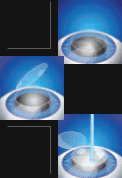Types of Refractive Surgery
Laser Assisted Intrastromal Keratomileusis (Lasik)
 In this procedure a flap one tenth of a millimetre in thickness (approximately the thickness of two hairs) is created and the excimer laser is then used to remove tissue from the deeper corneal stroma. Following this, the flap is repositioned without any disturbance to the surface. The procedure is done with local anaesthetic (eye drops) and is painless.
In this procedure a flap one tenth of a millimetre in thickness (approximately the thickness of two hairs) is created and the excimer laser is then used to remove tissue from the deeper corneal stroma. Following this, the flap is repositioned without any disturbance to the surface. The procedure is done with local anaesthetic (eye drops) and is painless.
Laser Epithelial Keratomileusis (Lasek)
This recently evolved procedure is a marriage between lasik and the older surface laser (PRK) whereby the surface epithelium is not removed but rolled into a scroll and then repositioned following excimer laser treatment.
Implantable Contact Lenses
Implantable Contact Lenses (ICL) are artificial lenses placed behind the pupil. 99% of patients are happy with these and say they "would have them inserted again".
10% of patients will have a small residual prescription and will need supplementary laser surgery to correct this. There is no additional charge for this, should it be necessary.
Refractive lens exchange
This procedure is done in older patients not suitable for laser and involves removal of the crystalline lens and insertion of either:
- A monofocal artificial lens giving excellent distance vision (but patients continue to need reading glasses); or
- A multifocal implant which gives excellent distance, near and reading vision.
What We Treat
- Myopia (Shortsightendess)
- Hyperopia (Longsightedness)
- Astigmatism
- Presbyopia
To treat these conditions, our practice offers a comprehensive range of ophthalmic refractive procedures including: lasik, lasek, implantable contact lenses (ICL) which are placed behind the pupil and refractive lens exchange
Am I Eligible for laser?
In general to be eligible you must:
- Be over 20 years of age
- Have a healthy cornea
- Have no significant change in their prescription for 12 months
Treatment Options for those Ineligible for laser
Implantable Contact Lenses (ICL)
An artificial lens is placed behind the pupil giving excellent distance vision. Advantages: good reading and distance vision without the need for glasses.
Refractive lens exchange
The crystalline lens is removed from the eye and an artificial lens is inserted. Patients can choose between a monofocal lens, which gives excellent distance vision (but patients continue to need reading glasses) or a multifocal implant which gives excellent distance and reading vision.


